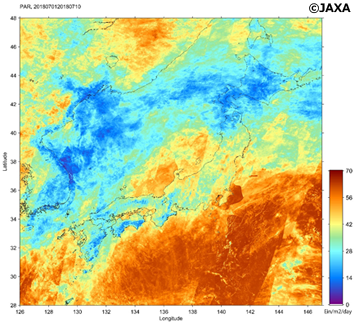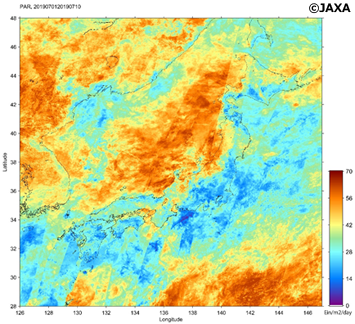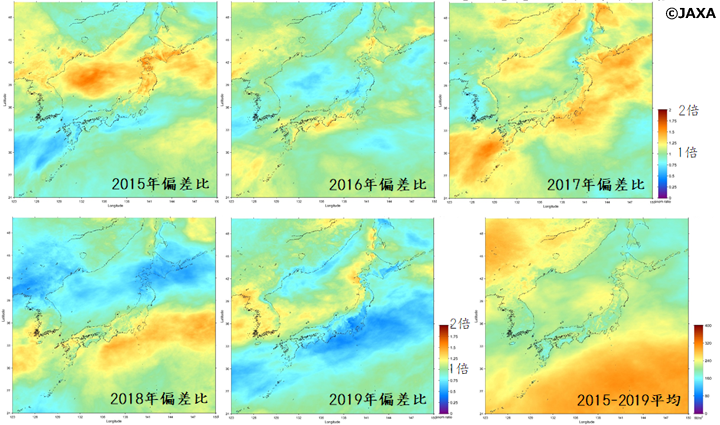

Meteorology and the Environment
2019.07.24 Wed
Record-breaking lack of sunshine in the Kanto region in 2019
This July, the Kanto region is suffering from a record-breaking lack of sunshine due to the rainy season in full swing, and there are concerns about the impact on vegetables and other crops. Observation data from Global Change Observation Mission – Climate “SHIKISAI” (GCOM-C) and Meteorological Satellite “Himawari-8” also indicated that solar irradiance was lower this year than last year.
Figure 1 shows the spatial distribution of photosynthetically active radiation, PAR (unit; Ein/m2/day) around Japan averaged over the 10-day period from July 1 to 10, 2018 (left) and 2019 (right) by GCOM-C. PAR is the sum of solar irradiance in visible wavelengths reaching the Earth’s surface that is used by plants for photosynthesis. We can see that PAR in the early July of 2019 around the Kanto area is about half that of 2018.
Figure 1. Photosynthetically active radiation averaged in early July (10 days from 1 to 10) in 2018 (left) and 2019 (right) by GCOM-C (unit; Ein/m2/day).
Figure 2 shows the solar irradiance around Japan in early July (10-day average from the 1st to the 10th) generated from the Himawari-8 observation data for the 5-year period from 2015 to 2019 (lower right: 5-year average; unit W/m2) and the spatial distribution of the ratio of solar irradiance to the 5-year average for each year. These figures clearly show the low amount of solar irradiance this year on the Pacific side of Japan, including the Kanto region where the amount of solar irradiance in the early July of 2019 was about half of the average of the past five years.
These annual variations in solar irradiance are closely related to the growth of vegetables and other agricultural products, as well as the amount of electricity generated by solar power and other renewable energy sources, and should be closely monitored in the future. Once the long rainy season is over, Japan may return to its extremely hot climate. It is still fresh in our memories that the Japan Islands was hit by an extreme heat wave on August 1, 2018. JAXA/EORC will continue to monitor the solar environment around Japan.
Observation images around Japan by GCOM-C are available on the “JASMES SGLI Near-Realtime Monitor”, a global environmental monitoring website. Observation images by Himawari are also available at “JAXA Himawari monitor“.
Explanation of the Images
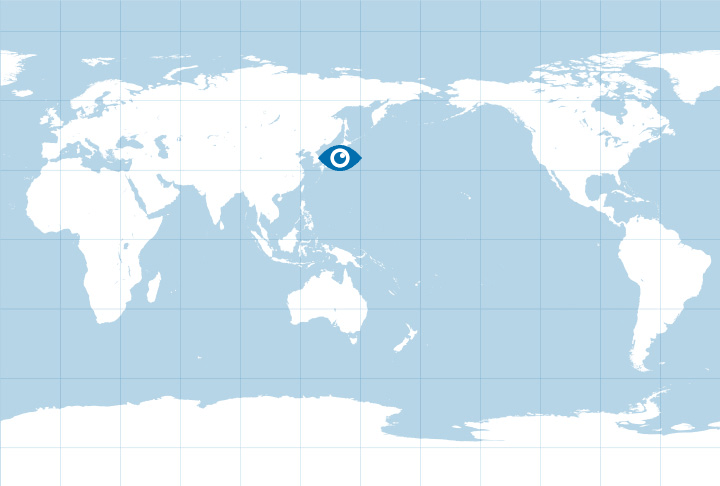
Figure 1
| Satellite | Global Change Observation Mission – Climate “SHIKISAI” (GCOM-C) |
|---|---|
| Sensor | Second generation GLobal Imager (SGLI) |
| Date | July 1-10, 2018 (left) July 1-10, 2019 (right) |
Figure 2
| Satellite | Geostationary Meteorological Satellite Himawari-8 |
|---|---|
| Sensor | Advanced Himawari Imager (AHI) |
| Date | July 1-10, 2015-2019 |
Related links
Search by Year
Search by Categories
Tags
-
#Earthquake
-
#Land
-
#Satellite Data
-
#Aerosol
-
#Public Health
-
#GCOM-C
-
#Sea
-
#Atmosphere
-
#Ice
-
#Today's Earth
-
#Flood
-
#Water Cycle
-
#AW3D
-
#G-Portal
-
#EarthCARE
-
#Volcano
-
#Agriculture
-
#Himawari
-
#GHG
-
#GPM
-
#GOSAT
-
#Simulation
-
#GCOM-W
-
#Drought
-
#Fire
-
#Forest
-
#Cooperation
-
#Precipitation
-
#Typhoon
-
#DPR
-
#NEXRA
-
#ALOS
-
#GSMaP
-
#Climate Change
-
#Carbon Cycle
-
#API
-
#Humanities Sociology
-
#AMSR
-
#Land Use Land Cover
-
#Environmental issues
-
#Quick Report
Related Resources
Meteorology and the Environment Related Articles
-
 Meteorology and the Environment 2025.05.20 Tue February 2025: Global Sea Ice Extent Reaches its Lowest in the History of Satellite Observations
Meteorology and the Environment 2025.05.20 Tue February 2025: Global Sea Ice Extent Reaches its Lowest in the History of Satellite Observations -
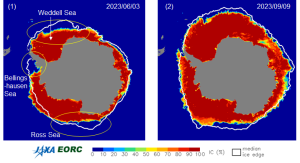 Meteorology and the Environment 2023.10.11 Wed Climate Change 2023 (2) : Antarctic Winter Sea Ice Extent Lowest Ever Recorded
Meteorology and the Environment 2023.10.11 Wed Climate Change 2023 (2) : Antarctic Winter Sea Ice Extent Lowest Ever Recorded -
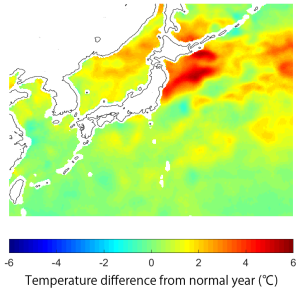 Meteorology and the Environment 2023.08.31 Thu Climate Change 2023 (1) : Sea Surface Temperature Rise and El Niño Event
Meteorology and the Environment 2023.08.31 Thu Climate Change 2023 (1) : Sea Surface Temperature Rise and El Niño Event -
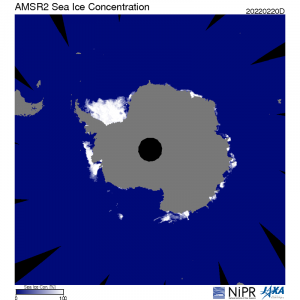 Meteorology and the Environment 2022.04.28 Thu Antarctic Sea Ice Extent Lowest Ever Recorded
Meteorology and the Environment 2022.04.28 Thu Antarctic Sea Ice Extent Lowest Ever Recorded










